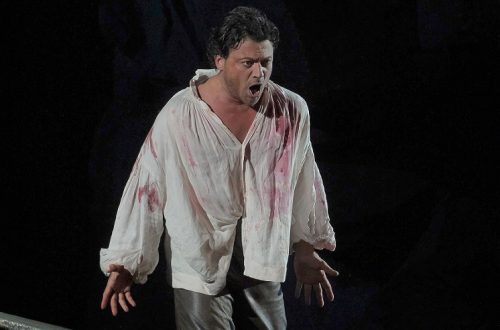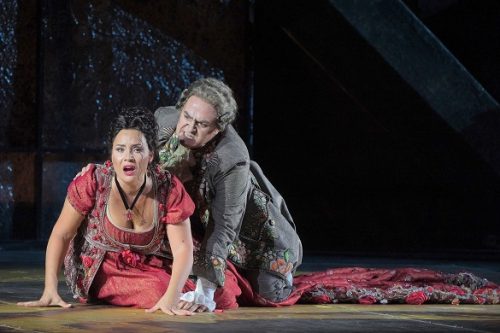 Italy Puccini’s Tosca at the 100th Arena di Verona Opera Festival 2023 [2]: Soloists, Children’s Choir (conductor: Elisabetta Zucca), Chorus (chorus director: Roberto Gabbiani) and Orchestra of Arena di Verona / Francesco Ivan Ciampa (conductor). Recorded (directed by Tiziano Mancini) at the Arena di Verona on 5.8.2023 and available on ARTE Concert until 12.11.2023. (JPr)
Italy Puccini’s Tosca at the 100th Arena di Verona Opera Festival 2023 [2]: Soloists, Children’s Choir (conductor: Elisabetta Zucca), Chorus (chorus director: Roberto Gabbiani) and Orchestra of Arena di Verona / Francesco Ivan Ciampa (conductor). Recorded (directed by Tiziano Mancini) at the Arena di Verona on 5.8.2023 and available on ARTE Concert until 12.11.2023. (JPr)

Production:
Direction, Set design, Costumes, Lighting design – Hugo de Ana
Cast:
Floria Tosca – Sonya Yoncheva
Mario Cavaradossi – Vittorio Grigòlo
Baron Scarpia – Roman Burdenko
Cesare Angelotti – Giorgi Manoshvili
The Sacristan – Giulio Mastrototaro
Spoletta – Carlo Bosi
Sciarrone – Dario Giorgelè
A Shepherd – Erika Zaha
Tosca must rank high amongst the operas that really need no introduction to readers of Seen and Heard International so some sentences from Verona’s website will suffice: ‘Puccini’s Tosca premièred in 1900, blending his established melodic and harmonic genius with a gripping immediacy, reminiscent of a cinematic thriller. This captivating story, crafted by Sardou, Illica, and Giacosa, coupled with Puccini’s unmatched theatrical intuition, creates a masterpiece brimming with dramatic tension and unforgettable arias […] It is no wonder Tosca, the sixth most performed title at the amphitheatre, commands a place in this year’s Festival repertoire.’ The production was premiered in 2006 and the set, costumes and lighting was the vision of Argentinian director Hugo de Ana and the website continues how his Tosca ‘has been successfully revived several times in recent decades. Sumptuous period costumes harmoniously blend with classic settings and imposing scenes, resonating with the spirit of the story. The unique stage seamlessly adapts to the three settings of the libretto, portraying the thriller set in nineteenth-century papal Rome, amid Bonapartist revolutionaries, opulence, darkness, mystery, and the iron rule of the ruthless Baron Scarpia. The colossal statue of the archangel Michael, symbolising divine justice and more, adds a compelling visual element.’
Having watched this on ARTE Concert there is little to disagree with here apart from how well what we see – in an unashamedly traditional Tosca – shows us those ‘three settings of the libretto’: inside the church of Sant’Andrea della Valle, Scarpia’s apartment in the Palazzo Farnese and the top of the Castel Sant’Angelo. (As expected?) the intimacy of Tosca is lost in the vastness of the famous Roman amphitheatre of 30 AD. At the start the Sacristan enters down the steps to the side of the vast stage with four misbehaving friars who will proceed to drag Cavaradossi’s workbench towards the vast painting of Jesus and Mary Magdalene he will be working on. There is much playing around with some preliminary sketches he has done and this would have been missed by most in the far reaches of the arena. Much else on the stage is draped in black although on one side is a vast hand with a rosary, hint of a wall and a couple of cannons. Later the painting is taken down and the huge head of archangel Michael is revealed and a large crucifix and two equally big candlesticks are brought on for the Te deum when there is more than a hint of Giorno dei Morti (Day of the Dead) to de Ana’s over-populated procession and the priests visible above the stage.

In close-up the costumes appeared well-worn but everyone looked as you would expect them to for Rome at the very beginning of the nineteenth century. Tosca was in embellished gold, bejewelled red and plainer blue during the three acts and sashayed around with her various shawls and notably Scarpia has a very elaborate frock coat in Act II. Scarpia’s apartment consisted of little more than two large (coffin-like) carved wooden chests with some odds and ends on them such as decanters and wine glasses, a crucifix of course, as well as some seashells. Oddly, the torturing of Cavaradossi remains unseen and below a trapdoor and Tosca seemed to find the knife she used to kill Scarpia stuck in part of what scenery there is.
For the last act, Cavaradossi is first spied in his cell high up at the back whilst two of the street urchins we first encountered in Act I are shown fishing in the Tiber (the orchestra pit!). There is a cross to which Cavaradossi will be loosely manacled as he is shot by the firing squad and Tosca does not jump from any ramparts but is last seen (or a double is?) with her back to the audience atop archangel Michael’s head with a crucifix in her right hand.
Francesco Ivan Ciampa is a name new to me but he has a burgeoning career and previously was assistant to Antonio Pappano and Daniel Oren. As heard through loudspeakers it was – what a colleague of mine calls – a correct performance. Ciampa seemed to keep the vast forces under firm control, both on the stage and in the pit, but it was all rather too lowkey, leisurely and reverential for the terror and passion to resonate in any meaningful way. This was often because the pauses in the action and the music sounded – at least to me – slightly longer than usual to often allow for entrances and exits due to the large distances being covered on the stage. Ciampa actually only generated light and shade and a more dynamic palette of sound during Act III with its orchestral prelude depicting dawn in Rome.
Verona mostly demands all the principal singers just fill their lungs and sing forte all the time so, finally, what about them? Vittorio Grigòlo is no longer welcome in the UK but his career in Europe continues to thrive. He is a vastly experienced Cavaradossi and his singing to the gallery approach was ideal for a performance in this arena but looked perhaps rather too effortful with the close-up camerawork. Grigòlo’s voice did not sound as if it has the freshness of earlier days and his ‘Recondita armonia’ was only so-so. His highlights were his full-throated ‘Vittoria! Vittoria!’ and the subsequent cursing of Scarpia and Tosca whilst being dragged away. ‘E lucevan le stelle’ was good if a little overwrought but there was a very tender ‘O dolci mani’ and it was clear in the subsequent duet his Cavaradossi never believed there would be a happy ending for him and Tosca.

Sonya Yoncheva was as convincing a Tosca as you are likely to see these days. For her raven-haired diva persona she seemed to be channelling another Verona favourite, Anna Netrebko. De Ana gives Tosca a moment in the spotlight for ‘Vissi d’arte’ and Yoncheva did not disappoint; her torment was clear to all and this pivotal aria was given a profoundly moving performance. Elsewhere Yoncheva’s Tosca showed that despite claiming she was religiously pious she was, as expected, intensely passionate and pathologically jealous – almost theatrically so – by turns.
If Grigòlo’s Cavaradossi and Yoncheva’s Tosca were frequently kissy-kissy, Roman Burdenko’s nasty, bullying and lascivious Baron Scarpia was sniffy-sniffy with Tosca’s fan and her hair getting his particular attention. For me, Burdenko’s acting was better than his singing which wasn’t sufficiently dark or convincingly malevolent. Nevertheless, his ‘Ebbene?’ (‘Well?’) when hinting at what Tosca must do to save her lover was as chilling as Tosca’s ‘Muori! Muori! Muori!’ was spat out vengefully after she despatched Scarpia
In the very solid supporting cast Giorgi Manoshvili impressed in his brief appearance as Cavaradossi’s fellow revolutionary Angelotti, Giulio Mastrototaro was a typically bustling Sacristan whilst Carlo Bosi stood out – as he always does in character tenor parts throughout the world – as Scarpia’s conniving henchman Spoletta. In the role of the Shepherd I suspect the winsome Erika Zaha elicited quite a few ‘ahhhhhhhs’ from the Verona audience.
Jim Pritchard

Grigolo is no Kaufmann or Calleja. He is adequate, but not outstanding. Yoncheva’s Tosca is magnificent. Burdenko’s Scarpia is menacing but not venal.